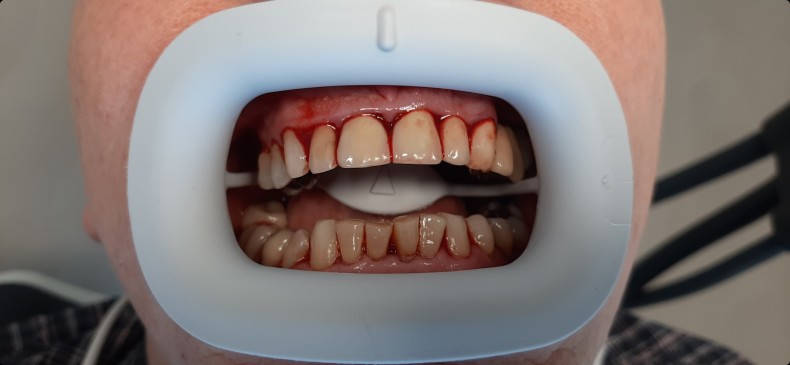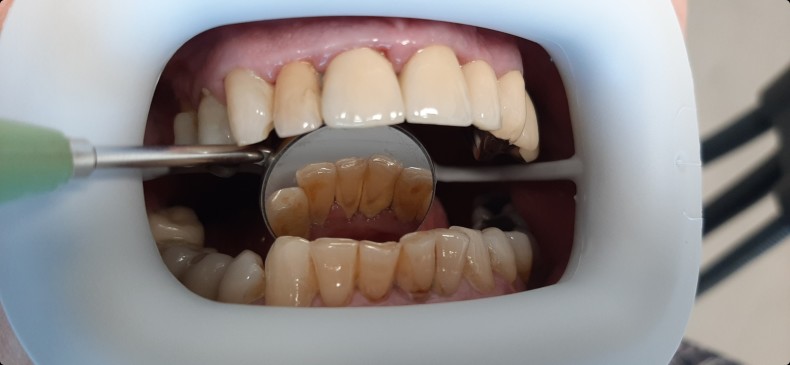Use of effective hypochlorous rinsing solution
Patient individuality in relation to the daily anamnesis, diagnosis and course of therapy should be realized in the professional treatment concept in every practice. Only through the structured processes implemented by the entire team can we successfully advise and instruct our patients in the long term.
Patients often suffer from general diseases which, in connection with taking medication, can lead to changes in the oral mucosa, burning and sensitivity. This can lead to significant limitations in daily oral hygiene. Patients who may already have a previous periodontal disease now have an even higher risk of developing serious illnesses due to the limited cleaning. Rheumatological and arteriosclerotic diseases also restrict the patient’s motor skills, which means that there is another serious factor that prevents adequate oral hygiene. Instruction in the use of electrically and/or sound-powered toothbrushes is also difficult with these diseases, since the disease can lead to deformities in the hands and the patient no longer feels their grip as sensitively. It is recommended to generally use a manual toothbrush with a reinforced handle, with which the patient can practice his or her remaining tooth brushing skills. Vibrations and sound technologies would only cause irritation when brushing teeth in patients with these pre-existing conditions. The limitations in oral hygiene usually result in a tighter recall system, in which medical/professional tooth cleaning (MZR/PZR) cleans the teeth and mucous membranes, such as the tongue, to be cleaned afterwards in order to ensure the lowest possible level of inflammation in the oral cavity.
gallery
diabetes mellitus
Periodontal and dental health can only be guaranteed with this regular support.Diabetes mellitus Our patients are getting older (demographic change), and with age the risk of suffering from general diseases increases. At the same time, the patient usually wants to age healthily and not restrict their quality of life. The effects of diseases such as high blood pressure and diabetes mellitus are often underestimated. By controlling these diseases well with medication, both the quality and the interaction between general health and dental health are significantly less at risk. Once the periodontitis has been identified and treated, the medication can be better adjusted for a diabetic, the Hb1Ac value improves and the inflammation of the periodontal tissue has a better healing process. The Hb1Ac value should ideally be around 6 to 6.5, and the patient with diabetes mellitus can have this value tested regularly by their family doctor or, if necessary, in the dental practice. A side effect of taking medication in diabetic patients is often dry mouth. The effects are the risk of caries, halitosis, redness and burning of the mucous membranes.
high blood pressure
The hypertensive patient often suffers from gingival hyperplasia and dry mouth as a side effect of the medication. Burning and reddening of the mucous membranes are side effects that also affect patients in their daily routine and reduce their quality of life. The daily medical history should include: information about new diseases, self-identified changes in the oral cavity, e.g. B. Burning tongue, reddened gingiva ect., medications and oral hygiene items already used, so that we can pick up the patient with instructions where his individual needs are.
halitosis
bad breath (halitosis) etc. is another side effect of dry mouth and deposits in areas of the oral cavity that are difficult for the patient to access or sensitive, such as cavities, implants, denture constructions, pontics and the tongue. For this group of patients, halitosis means major limitations in their quality of life, to the point of avoiding social contacts.
Gentle hypochlorite rinsing solutions (HOCl)
These patient groups should usually be instructed in the use of a mild yet highly effective mouthwash solution (e.g. Veriforte med Oral) that works on a hypochloric basis. These can be used therapeutically indefinitely and do not lead to any side effects, such as discoloration of teeth and tongue, taste disorders or burning or changes in the mucous membranes, even with long-term use. The solutions bathe unicellular microorganisms. The hypochlorous acid denatures the cell wall (structural change) and increases its permeability. The hypotonic solution ensures that water flows into the cells to compensate for the osmotic gradient. The increasing internal cell pressure leads to non-specific osmotic shock, which causes the cells to burst (osmolysis).
Technology/Bioprophylaxis
HOCI with its preservative property is an essential ingredient. It is one of the end products of a physiological pathway in human white blood cells that fights invading pathogens as part of the natural response. A major challenge in the production of HOCl solutions is the stability at a neutral pH value, which is guaranteed when producing this rinsing solution. In the patient case of this article, the Veriforte med Oral rinsing solution was used. This consists of water, sodium chloride, sodium hypochlorite and hypochlorous acid, which is stabilized using a particularly environmentally friendly technology. The solution reduces the microbial load caused by the mechanical action of rinsing and, with regular use, reduces the risk of infection. It can also be disposed of with the waste water without any problems, as there is no risk to drinking water due to its composition.
Fields of application of HOCl rinsing solutions
- Cleaning and decontamination of wounds in the oral cavity and gums
- Removal of plaque from the tongue and teeth
- Rinsing before and after oral surgery and tooth extraction
- Treatment of aphthous ulcers and gum injuries
- Reduction of bad breath
geriatrics, palliative care and intensive care
- General oral hygiene and problems with dentures that cause pressure sores and inflammation
- Routine oral hygiene in intensive care patients
oncology and radiotherapy
- When problems arise in the oral cavity
Application
- The flushing time is 30 seconds. The solution has a neutral pH value and can be used indefinitely.
user groups
- Patients with changes and inflammation of the gingiva and periodontally diseased patients
- Patients with sensitive mucous membranes
- pregnant women
- children from six years of age
- Alcoholics/dry alcoholics
- halitosis patients
patient case
In the photo documentation (Fig. 1-4) only one of numerous patient cases in our practice is documented. The 70-year-old new patient had been noticing changes in the oral mucosa for some time, with symptoms such as burning, redness and dryness. He is multimorbid, takes various medications for high blood pressure and diabetes mellitus as well as blood thinners and beta blockers. He also suffered from heart failure and rheumatologic arthritis. The findings in the screening program (ParoStatus.de) revealed that the new patient was suffering from acute periodontitis with probing depths of up to 8 mm, a plaque index of 100 percent and a BOP (bleeding on probing) of 100 percent . Thanks to the periodontal treatment that was carried out systematically and the oral hygiene products explained in the MHU, including the hypochloric rinsing solution, the patient is currently free of symptoms and very grateful for his regained quality of life. The patient continues to use the rinsing solution twice a day.
Conclusion
Various options and articles for supporting and accompanying recommendations are available for individual oral hygiene instructions for patients. The daily updated anamnesis can be used to identify the symptoms the patient is suffering from and which general illnesses and medications are the underlying causes. Patients with limitations in the motor area due to rheumatological and arteriosclerosis diseases and the deformations of the limbs caused by them need auxiliary aids such as rinsing solutions for their oral hygiene at home in order to keep plaque accumulation as low as possible and to counteract inflammation of the gingiva. If symptoms such as burning of the oral mucosa, sensitive mucous membranes or halitosis are aggravated, effective yet gentle products for oral hygiene at home must be recommended to the patient from the wide range of oral hygiene aids available. Hypochlorous-based rinsing solutions have become indispensable in our everyday practice due to their mild yet highly effective composition.
This article has the original title “Individual oral hygiene instructions for PAR therapies” in the PJ Prophylaxis Journal appeared.





